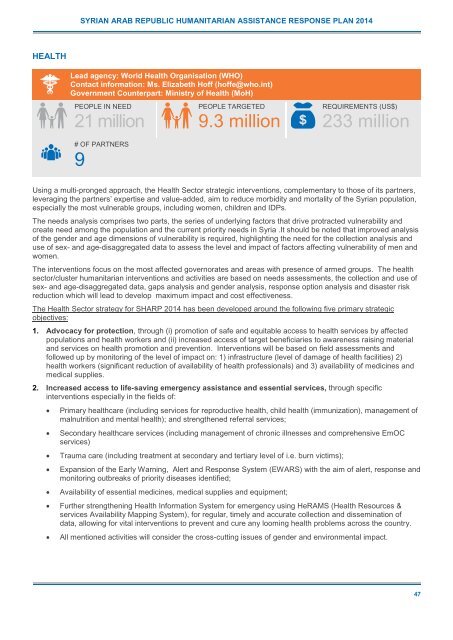2014 Syrian Arab Republic Humanitarian Assistance Response Plan (SHARP)
- No tags were found...
Create successful ePaper yourself
Turn your PDF publications into a flip-book with our unique Google optimized e-Paper software.
SYRIAN ARAB REPUBLIC HUMANITARIAN ASSISTANCE RESPONSE PLAN <strong>2014</strong><br />
HEALTH<br />
Lead agency: World Health Organisation (WHO)<br />
Contact information: Ms. Elizabeth Hoff (hoffe@who.int)<br />
Government Counterpart: Ministry of Health (MoH)<br />
PEOPLE IN NEED<br />
21 million<br />
PEOPLE TARGETED<br />
9.3 million<br />
REQUIREMENTS (US$)<br />
233 million<br />
# OF PARTNERS<br />
9<br />
Using a multi-pronged approach, the Health Sector strategic interventions, complementary to those of its partners,<br />
leveraging the partners‟ expertise and value-added, aim to reduce morbidity and mortality of the <strong>Syrian</strong> population,<br />
especially the most vulnerable groups, including women, children and IDPs.<br />
The needs analysis comprises two parts, the series of underlying factors that drive protracted vulnerability and<br />
create need among the population and the current priority needs in Syria .It should be noted that improved analysis<br />
of the gender and age dimensions of vulnerability is required, highlighting the need for the collection analysis and<br />
use of sex- and age-disaggregated data to assess the level and impact of factors affecting vulnerability of men and<br />
women.<br />
The interventions focus on the most affected governorates and areas with presence of armed groups. The health<br />
sector/cluster humanitarian interventions and activities are based on needs assessments, the collection and use of<br />
sex- and age-disaggregated data, gaps analysis and gender analysis, response option analysis and disaster risk<br />
reduction which will lead to develop maximum impact and cost effectiveness.<br />
The Health Sector strategy for <strong>SHARP</strong> <strong>2014</strong> has been developed around the following five primary strategic<br />
objectives:<br />
1. Advocacy for protection, through (i) promotion of safe and equitable access to health services by affected<br />
populations and health workers and (ii) increased access of target beneficiaries to awareness raising material<br />
and services on health promotion and prevention. Interventions will be based on field assessments and<br />
followed up by monitoring of the level of impact on: 1) infrastructure (level of damage of health facilities) 2)<br />
health workers (significant reduction of availability of health professionals) and 3) availability of medicines and<br />
medical supplies.<br />
2. Increased access to life-saving emergency assistance and essential services, through specific<br />
interventions especially in the fields of:<br />
<br />
<br />
<br />
<br />
<br />
<br />
<br />
Primary healthcare (including services for reproductive health, child health (immunization), management of<br />
malnutrition and mental health); and strengthened referral services;<br />
Secondary healthcare services (including management of chronic illnesses and comprehensive EmOC<br />
services)<br />
Trauma care (including treatment at secondary and tertiary level of i.e. burn victims);<br />
Expansion of the Early Warning, Alert and <strong>Response</strong> System (EWARS) with the aim of alert, response and<br />
monitoring outbreaks of priority diseases identified;<br />
Availability of essential medicines, medical supplies and equipment;<br />
Further strengthening Health Information System for emergency using HeRAMS (Health Resources &<br />
services Availability Mapping System), for regular, timely and accurate collection and dissemination of<br />
data, allowing for vital interventions to prevent and cure any looming health problems across the country.<br />
All mentioned activities will consider the cross-cutting issues of gender and environmental impact.<br />
47



